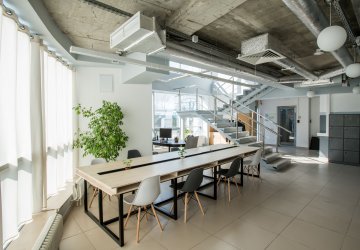What is Space Management?
Space management refers to the way organisations manage their physical space to support objectives for profitability, sustainability, productivity and employee wellbeing. It is a critical process for modern workplaces, ensuring that resources are used effectively, operational costs are reduced, and employee satisfaction is prioritised.
While every organisation needs space to support its operations, the term ‘space’ itself has many connotations. It can refer to a single room with one or two desks, an entire floor, multiple floors within a single building, or even multiple floors across a global building portfolio. But regardless of its size or purpose, managing space effectively and strategically is a universal challenge for every organisation. This makes space management applicable to a wide range of settings, from government organisations, university campuses, and financial institutions, to healthcare institutions, factories, warehouses, retail chains, and many more facility types.
The benefits of Space Management
A well-managed space helps organisations achieve key goals by streamlining how space is utilised. These benefits can be categorised as:
- Cost Efficiency: By identifying and repurposing underutilised spaces, organisations can reduce real estate expenses and streamline operations.
- Improved Resource Allocation: Aligning energy usage and HVAC systems with occupancy data minimises waste and maximises efficiency.
- Enhanced Productivity: Comfortable and functional spaces boost morale and enable employees to work more effectively.
- Sustainability Gains: Energy-efficient designs and reduced waste support corporate environmental goals while lowering operational costs.
- Minimised disruptions: Coordinating maintenance activities with location and occupancy data ensures technicians know where to go and that maintenance work is only scheduled when spaces are available.
For example, companies implementing data-driven space management strategies often report real estate cost reductions of up to 30%, while also boosting employee satisfaction and productivity.
Space Management by industry
By using effective space management tactics, organisations can ensure that every square foot of a space is fully optimised. This requires companies to consider the evolving dynamics of modern work environments while aligning the needs of employees and visitors with business objectives. This involves striking a balance between creating functional and engaging spaces on the one hand, and achieving strategic goals on the other.
Depending on the type of business or organisation, optimising space management can vary significantly based on unique needs, priorities, and operational goals. Here are a few examples of the role of space management for different types of organisation:
By tailoring space management strategies to the specific requirements of different industries, organisations can achieve better alignment with their operational objectives, improve resource utilisation, and enhance the experiences of employees, customers, and other stakeholders.
The impact of flexible and
hybrid work
In the context of flexible and hybrid work models, space management takes on an even greater level of importance. With a workforce being more agile than ever, organisations seem to have no other choice than to embrace flexible working conditions – both onsite and offsite.
To accommodate changing workforce dynamics, organisations must adopt strategies such as dynamic seating arrangements, reservable workspaces, and dedicated collaboration zones. These adaptations create environments that support both in-office and remote workers, fostering engagement and productivity regardless of where employees are working.
Allocated vs Shared Spaces
Spaces can be configured to be allocated or shared.
Allocation of workspaces to specific employees often happens based on position or activity-based workflows. For example, graphic designers may require workstations equipped with specialised tools such as colour-calibrated screens, high-performance computers, or ergonomic setups to support their creative processes. Similarly, CEOs and other executives may require spaces designed to ensure privacy and confidentiality, such as private offices or meeting rooms with secure communication systems and sound-isolating walls.
Shared or flexible spaces are versatile areas designed to be used by multiple individuals or teams based on their needs. Examples include shared spaces for marketing, sales or development teams, dedicated concentration rooms, or meeting rooms with video conferencing setups and whiteboards. Flexible space approaches highlight the ability to assign or share spaces based on the real-time needs of multiple users.
Different types of flexible workplace approaches
Depending on an organisation, many terms are used to categorise workplace strategies, such as:
Hot Desking
A system where employees do not have assigned desks but use available workstations on a first-come, first-served basis.
A system where employees do not have assigned desks but use available workstations on a first-come, first-served basis.
Hotelling
A reservation-based system where employees book a specific workspace in advance.
A reservation-based system where employees book a specific workspace in advance.
Flexible workspaces
Designing adaptable layouts to meet evolving organisational requirements.
Designing adaptable layouts to meet evolving organisational requirements.
Shared Workspace
Spaces that are designed to be used by multiple teams or departments, often with shared resources like meeting rooms or collaborative zones.
Spaces that are designed to be used by multiple teams or departments, often with shared resources like meeting rooms or collaborative zones.
Dynamic Space Allocation
The process of reallocating space based on real-time needs and usage data.
The process of reallocating space based on real-time needs and usage data.
Activity-Based Workspaces (ABW)
Areas tailored for specific activities, such as collaboration zones, focus areas, or social spaces, that can be shared by multiple users.
Areas tailored for specific activities, such as collaboration zones, focus areas, or social spaces, that can be shared by multiple users.
These concepts are central to modern flexible workplace strategies, ensuring that space is utilised efficiently and adaptively to meet the needs of employees and the organisation.
Common strategies to optimise Space Management
To optimise space efficiency, new workplace managers often showcase a hands-on approach by moving furniture, rearranging desks and making small layout changes. While these initial efforts can yield immediate results, organisations can implement more strategic approaches to maximise their physical spaces. These strategies not only address current and future workplace needs, but also put the employee experience at the forefront:
- Flexible Workspaces: Shared spaces, such as hot-desking arrangements, are ideal for hybrid work models. They allow organisations to accommodate fluctuating workforce numbers while ensuring employees have access to the resources they need, whether working on-site or remotely.
- Space Zoning: Designating specific areas for distinct activities enhances functionality and ensures that each zone serves a clear purpose. Examples of this include quiet zones for focused work and collaboration areas for teamwork or downtime.
- Multi-Functional Spaces: Smaller offices may look to create rooms that serve multiple purposes, such as meeting spaces that also function as informal workstations. This makes the most out of the space and adapts to the diverse needs of employees.
- Data-Driven Optimisation: Rather than just guessing what is required with the office space, organisations can make use of tools such as occupancy sensors and management software that provide real-time data, enabling them to make informed decisions about space allocation, layout adjustments, and resource distribution.
- Employee Wellbeing: Another strategy is to focus on optimising the comfort of spaces to support occupant health and wellbeing through improved Indoor Air Quality (IAQ) and sanitisation management.
3 key elements of any space management strategy
Space management is built around three fundamental pillars:
- Space Planning: Space planning lays the groundwork for effective management. It involves creating strategic layouts and designs that align with an organisation’s goals. Offices, meeting rooms, and collaboration areas are carefully arranged to maximise utility and support specific work styles. This forward-thinking approach ensures spaces can adapt to both current and future needs.
- Space Utilisation: Analysing how spaces are being used helps organisations identify inefficiencies and opportunities for improvement. By examining metrics like occupancy rates and usage patterns, businesses can repurpose underutilised areas to better meet the needs of their workforce, ultimately improving overall efficiency and reducing costs associated with buying more space.
- Space Optimisation: Space optimisation builds on planning and utilisation by applying strategies that dynamically adapts spaces to changing occupant demands.
To put it simply: to make a space management strategy successful, you have to track how much space an organisation has, manage occupancy information, and devise strategic spatial plans to ensure effective usage.
Space Management as a component of FM solutions
Regardless of the space configuration, it’s obvious that having a clear understanding of the number of spaces and their usage is a fundamental component of effective facility management. This insight underpins key facility management activities, including:
- Occupancy tracking
- Move management
- Room reservations
- Maintenance scheduling
- Property management
By leveraging integrated software solutions, such as Planon’s award-winning Space and Workplace Services Management solution, organisations can gain real-time visibility into their space usage, to improve operational efficiency, and foster a more engaging, productive environment for everyone.
To achieve this agility, many organisations are leveraging space management systems and complementary hardware. Tools like occupancy sensors, analytics platforms, and digital twins provide real-time insights, enabling data-driven decisions to optimise floor layouts, manage resources, and adapt to shifting needs. By combining strategic planning with innovative technology, businesses can create vibrant, efficient, and future-ready environments that support their employees and drive organisational success.
Global success stories

BayWa - Hybrid working with the Planon Workplace App
Case study on using the Planon Workplace App at BayWa to support hybrid working.
Explore now
Tegel Projekt GmbH & Disruptive Technologies
Case study on the digitalisation of Tegel Projekt GmbH's building operations using IWMS and sensors.
Explore now
Bayer Corporate Real Estate & Hexagon
This case study shows how a digital twin of rooms and facilities was integrated into Bayer Corporate Real Estate’s Planon IWMS solution. This was done in collaboration with Hexagon in order to further digitalise and optimise CREM & FM processes.
Explore nowThe benefits of Space Management software
Using space management software to manage an organisation’s space offers many benefits.
1. Lower portfolio costs
Two of the largest expenses for an organisation are personnel and real estate costs. Effective space management has a direct impact on both cost centres, making it a critical component that can greatly impact the bottom line of a business.
Ideally, an organisation would use every inch of their space for the intended purpose, whether it be meeting rooms, storage, labs, desks, or dining space. Using space management software provides the accurate and real-time data that is needed to see if spaces could be used more effectively to reduce costs.
This means that organisations can re-allocate spaces that aren’t being used for a more appropriate purpose or even make a case for, or against, the need for an expansion based upon real-time data. An organisation with a space management team that is equipped with real-time, accurate data, can make better decisions that will drastically cut real estate portfolio costs.
To ensure that employees remain satisfied and engaged, Facility and Space Managers must provide employees with workspaces that meet their needs. This means providing enough physical space to perform daily tasks comfortably and effectively, but not so much that the organisation pays for space that is not needed. Space Managers have begun to explore how to provide different types of spaces for different purposes. This could include quiet rooms for employees who do not want to be disturbed, or creative spaces with comfortable chairs that encourage employees to brainstorm, innovate, and collaborate with others in a less formal setting.
An innovative space management software solution provides clear insights into space occupancy and space usage. This data can help space management teams draw better conclusions and recognise trends about the space they provide, enabling them to work on initiatives that meet the real needs of employees. If the data shows that certain spaces, such as concentration rooms, are continuously occupied, this might be an indication that there is a high need for this type of space. If you see that the occupancy rate of open-plan offices is extremely high, this may indicate that employees prefer more collaborative engagement thus action needs to be taken to improve this. These are just a few examples. If your space management team has better data to work with, they can provide better insights and explore potential problems or solutions more quickly.
Access to consistent, accurate space data also allows you to make it easier for employees to find and book available space, whether through a self-service portal, a mobile device, a kiosk or room booking panel. In the end, happy employees perform better, stay with an organisation longer, and are more productive.
46% of real estate and facilities directors rate improving occupant comfort as a top priority in the near future.
~Verdantix
Occupancy data can also be used to adjust ventilation in conference and meeting rooms to improve indoor air quality (IAQ). When too many people stay in a closed room for too long, CO2 levels can rise quickly, leading to fatigue and reduced concentration, which affects productivity. In high-occupancy rooms, ventilation levels should be increased to help reduce the spread of viruses and support health and safety.
Beyond immediate energy savings, repurposing underutilised spaces can significantly reduce the need for new construction, which is often a carbon-intensive process. For instance, an organisation considering expanding office space might use space management software to analyse whether existing spaces, such as unused storage rooms or oversized conference areas, could be converted into functional workstations or collaboration hubs.
On a larger scale, organisations can apply these insights across multiple locations to optimise their real estate portfolio. For example, a global company may identify that a facility consistently operates at 50% capacity. Armed with this data, they could consolidate operations into fewer buildings, cut maintenance costs, and even sell or lease the underused property—all while avoiding unnecessary energy consumption and reducing their overall carbon footprint.
These practical measures demonstrate how sustainability initiatives supported by space management software directly align with ESG goals. By combining data-driven decisions with resource optimisation, organisations can showcase measurable progress, from energy savings to reduced operational emissions, in their sustainability reports and stakeholder communications.
4. Generate reports to develop strategic space plans
Without having software for space management in place, it becomes difficult and time consuming to run reports on real-time and accurate space data as the data is simply not centralised in one system. In addition, when space data is spread out and stored at different locations, redundancies can occur, making it more difficult to know which dataset is more up to date. An innovative software solution for space management, ideally integrated into an Integrated Workplace Management System (IWMS), centralises all data into one system, collecting it automatically in real-time. With a space management module and IWMS in place, Facility and Space Managers can run reports such as chargeback reports and utilisation reports and use scenario planning for future space allocation. Based on these reports, Facility and Space Managers are able to monitor and analyse their space management data and plan for future improvement.
Whilst there are some excellent space management point solutions in the market, organisations will get the most out of their space management when combining it with an IWMS solution. With an IWMS, organisations can consolidate all their separate, fragmented sets of data for maintenance management, property and lease management, services management and sustainability management. This allows all stakeholders to work together better, each seeing accurate, up-to-date data that can aid in decision making across all participating departments.
Space Management FAQs
Space management requires collaboration across multiple roles, each bringing unique expertise to the table. Key contributors include:
- Facility Managers: Responsible for daily operations and ensuring that spaces remain functional and efficient. These activities can be provided by an internal department or by an outsourced service provider.
- Space Planners: Experts in designing and implementing layouts that align with the organisation’s goals and employee needs.
- Workplace Strategists: Focused on integrating space management into broader business strategies, such as sustainability initiatives or hybrid work models.
- HR, IT, and Operations Teams: These departments collaborate to incorporate technology and create environments that prioritise employee satisfaction.
By working together, these roles ensure that space management initiatives are comprehensive and successful.
Modern space management relies heavily on technology to enhance efficiency and flexibility. Space management software integrations and options include:
- Occupancy Sensors: These devices monitor space usage in real time, offering actionable insights into how facilities are utilised.
- Interactive Floor Plans: Visualisation tools simplify the process of designing and adjusting layouts to optimise space allocation and to track the location of mobile equipment for improved inventory and resource management.
- AI-Driven Insights: Predictive analytics tools help organisations anticipate future space needs based on historical data.
- Building Management Systems (BMS): IoT-enabled systems dynamically adapt environments to meet real-time usage demands.
- Room Booking Panels: These tools streamline the scheduling of meeting rooms, ensuring equitable access and avoiding conflicts.
- Marketplace: This extends software from stand-alone solutions to open platforms and complete ecosystems. Apps are offered as add-on applications, or integrations with third-party vendors, for example.
The best space management software enhances employee experience, boosts engagement, reduces costs, and supports overall workplace strategies. It stands out by combining robust functionality, user-friendly interfaces, and innovative features tailored to meet the diverse needs of organisations. By providing real-time data and actionable insights, they enable organisations to make informed decisions about layout adjustments, resource allocation, and space utilisation. Space management software should also promote adaptability within hybrid work models, ensuring that spaces meet both business objectives and employee needs.
The main characteristics of top-tier space management software include:
1. A Comprehensive Feature Set
- Real-Time Data and Analytics: The ability to monitor space utilisation, occupancy rates, and trends in real time for making informed decisions.
- Integration with IoT Devices: Seamless connectivity with occupancy sensors, lighting systems, and HVAC controls to optimise energy usage and employee comfort.
- Space Planning and Visualization: Interactive floor plans and tools for designing, reconfiguring, and visualising spaces to meet changing needs.
- Room Booking Systems: Simplified scheduling for shared spaces, such as meeting rooms, with options for mobile and kiosk-based reservations.
- Customisation Options: Flexibility to adapt the software to specific organisational needs, such as industry-specific workflows or branding.
2. Ease of Use
- Intuitive Interface: Simple, user-friendly dashboards for employees and administrators to access and manage spaces effortlessly.
- Mobile Access: Compatibility with mobile apps for employees to book spaces or check availability on the go.
- Self-Service Portals: Empowering employees to manage their workspace needs without administrative bottlenecks.
3. Scalability and Flexibility
- Software that grows with the organisation, supporting everything from medium to global building portfolios.
- Accommodation for different work models, including hybrid and flexible work arrangements, by offering features like hot-desking and activity-based workspaces.
4. Data-Driven Insights
- Advanced analytics and reporting capabilities that help organisations track KPIs like space utilisation, cost efficiency, and employee satisfaction.
- Predictive analytics to anticipate future space needs and trends, allowing for proactive planning.
5. Integration Capabilities
- Compatibility with third-party tools and systems, such as HR software, CRM systems, or building management systems (BMS).
- Access to a marketplace of add-ons and integrations for enhanced functionality, such as energy monitoring, AI-driven insights, or third-party hardware such as room booking panels.
6. Focus on Employee Experience
- Features that promote employee satisfaction, such as options for reserving quiet zones, collaboration spaces, or ergonomic desks.
- Transparent availability and booking systems to reduce frustrations and ensure equitable access to resources.
7. Security and Compliance
- Adherence to data security standards and privacy regulations, ensuring sensitive data (such as booking or occupancy records) is protected.
- Role-based access control to safeguard against unauthorised access.
8. Sustainability Features
- Support for green initiatives, such as energy-efficient space designs and the ability to track energy consumption and parameters of indoor air quality and comfort metrics.
- Tools to monitor carbon footprint and implement eco-friendly space optimisation strategies.
The best space management software is not a one-size-fits-all solution. It is adaptable, innovative, and designed to align with both organisational goals and employee needs. By choosing a software solution that balances these key features, businesses can create efficient, flexible, and engaging work environments while staying ahead in an ever-evolving workplace landscape.
To achieve success in space management, organisations should adopt these best practices:
- Conduct Regular Space Audits: Periodic evaluations of space usage help identify inefficiencies and uncover opportunities for improvement.
- Implement Flexible Layouts: Open offices, collaboration zones, and adaptable workspaces ensure that spaces meet evolving needs.
- Foster Cross-Departmental Collaboration: Encouraging communication between HR, IT, and facilities teams ensures alignment on goals and strategies, promoting cohesive space management efforts.
Emerging trends highlight the evolving role of space management in modern workplaces:
- Hybrid Workspaces: Reflecting a shift toward improving occupant experience, hybrid workspaces prioritise flexibility, combining shared resources and adaptable layouts to support employees across both in-office and remote work contexts.
- Smart Buildings: Utilising IoT and AI technologies to monitor and manage spaces in real time.
- Sustainability Initiatives: Designing energy-efficient layouts and adopting green practices to minimise environmental impact and support employee health, safety, and wellbeing.
- Multi-Purpose Spaces: Creating versatile areas that cater to diverse organisational needs while maximising utility.
Read more in our 8 trends whitepaper
Learn more about Space Management

Why effective Space Management is fundamental to a successful working experience
This e-book addresses the importance of creating an optimal working experience and explains which elements of space management contribute to it.
Read more
Effective space management: key elements to consider
In this co-hosted webinar, Verdantix addressed the importance of space management whereas Planon discussed its key elements and provided practical examples of how facility managers could make their space management practices more effective. 43:16 English
Read more
Planon Space & Workplace Services Management
By providing visibility into the distribution and occupation density of all space, Planon's Space & Workplace Services Management solution enables your organisation to reduce costs by ensuring the proper utilisation of all space, and actually matching space utilisation with departmental demands.
Read more



